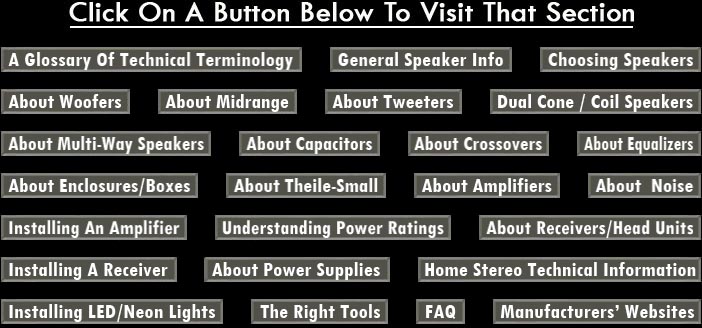


A-B Test
A test by which an observor subjectively compares the performance of two components of the same type; for example, a test between two different speakiers. For the test to be scientifically valid, the inputs, levels, and listening conditions should be matched.
ABX Comparator
A device that randomly selects between two components being tested. The listener doesn't know which device is selected.
Acoustic Coupling
The interaction between two or more speakers stacked together in an audio system which may produce a sound different from (and often better than) the sound produced by the individual speakers.
Acoustic feedback
A phenomenon where the sound from a loudspeaker is picked up by the microphone or other transducer, like a phono cartridge feeding it, and re-amplifys it through the same loudspeaker only to return to the same microphone to be re-amplified again, etc.. Each time the signal becomes larger until the system runs away and rings, or feeds back on itself producing the characteristic scream or squeal found in sound (mostly, PA) systems. These buildups often occur at particular frequencies called feedback frequencies.
Acoustic Suspension (enclosure)
A Sealed box system that uses the resistance of the internal air of a sealed enclosure to control the motion of the cone. Sometimes known as an infinite baffle type.
Acoustics
Sound is simply vibrating air. How fast, how much, and when the air is vibrated, determines what we will ultimately hear as sound. The science of this process is called acoustics.
When a speaker cone (or anything else that has the ability to vibrate in the auditory range) moves forward, the air molecules in front of the cone are compressed, causing the molecules to form an accelerating wave forward. This continues to happen until the speaker cone moves in the opposite direction, which causes a rarefaction (or thinning) of the air mass between the speaker and the listener. This is the basic concept of how sound waves are produced.
Active
A word prefacing certain circuits in which the processing is performed by use of transistor or tube juctions, rather than passive componenets such as resistors, capacitors, and coils. Such items as crossovers and equalizers may be constructed either way. Active processing usually affords more more options, and greater precision, albeit at greater cost.
Active Display
A special feature for front panel receiver displays that generates animated patterns for both segmented and dot matrix LCDs that proceed the sequential display of information such as clock, CD titles, and radio station call letters and frequencies.
AC-3
(audio coding 3) Dolby's digital audio data compression algorithm adopted for HDTV transmission and used in DVDs, laserdiscs and CDs for 5.1 multichannel home theater use and automotive surround application.
Adaptive Reception
A circuit that provides adjustable delay such that the time at which a sound wave is produced from various signal channels can be changed. This allows synchronization for each channel of a multi-channel output device, so that sound waves from multiple speakers will converge at approximately the same time at a single point in space (the listener).
Air Gap
In a speaker's motor section, the space between the top plate and the pole piece. This is where the magnetic flux field is concentrated and where the voice coil interacts with it.
AIFF
Short for Audio Interchange File Format, a file format for storing and transmitting sampled sound. It was developed by Apple Computer and is the standard audio format for Macintosh computers. Files are 8-bit mono or stereo and generally end with a .AIF or .IEF extension. Normal AIFF does not support data compression so files tend to be large, but another format called AIIF-Compressed (AIFF-C or AIFC) does support compression.
Alternating Current
Electricity which flows in opposite directions, alternating at a certain rate (Hz). As supplied by power companies, AC in the United States alternates 60 times per second and is deemed as 60 Hz power. However; some countries have a 50 Hz system, and ships and aircraft may use 400 Hz.
Alternator Whine
A siren-like whining that appears as the rotational speed of an engine increases. The noise is usually the result of a voltage differential created by more than one ground path or a poor ground path to the affected equipment.
Amperes (A
)
Ampere is a unit measurement of current of electrical energy equal to one coulomb of charge per second. Most DC applications refer to positive current - current which flows from a positive potential to a more negative potential, with respect to a reference point which is designated as zero or neutral potential (usually ground).
The electrons in a circuit flow in the opposite direction as the current itself. Ampere is commonly abbreviated as "amp", not to be confused with amplifiers, of course, which are also commonly abbreviated "amp". In computation, the abbreviation for amperes is commonly, "I".
Amplifier
A device, either a single stage or a large scale circuit with mutiple stages for creating gain, ie. making small signals larger.
Amplification Classes
All sound is a sinosoidial waveform. It has alternating peaks and valleys. The center point of each wave is the zero, or switching point that separates the positive (top) from the negative (bottom) portion of each wave. When a tube or transistor amplifier operates in Class A, the output tubes or transistors amplify the entire waveform without splitting it into positive and negative halves. In Class AB, used in the overwhelming majority of amplifier designs, the signal is split into two halves, positive and negative, and each half is sent to a tube or transistor circuit for amplification. Both sides work in tandem, and the two halves are recombined at the output section to reconstruct the whole signal. This technique increases the amount of power that can be applied, but increases distortion. Class A amps usually provide lower, often imperceptable distortion, but at the expense of reduced power output.Class D or High Current operation is essentially rapid switching, hence the term switching power amplifier. Here the output devices are rapidly switched on and off at least twice for each cycle. Theoretically, since the output devices are either completely on or completely off they do not dissipate any power. If a device is on there is a large amount of current flowing through it, but all the voltage is across the load, so the power dissipated by the device is zero; and when the device is off, the voltage is large, but the current is zero. Consequently, class D operation (often, but not necessarrily digital) is theoretically 100% efficient, but this requires zero on-impedance switches with infinitely fast switching times -- a product yet to be made; meanwhile designs do exist with efficiencies approaching 90%. This is a design that is increasimgly popular for use in bass systems, where maximum power is necessary, and slightly elevated levels of distortion are easily tolerated.
Amplitude
The strength or intensity of an AC signal applied by the amplifiers output to a speaker's input. Also, a measure of the relative power of any variable recurring phenomenon. Typically, measurements are made in Decibels.
Amplitude Modulation (AM)
In radio broadcasting, amethod of modulation in which the amplitude of the carrier voltage is varied in proportion to the changing frequency value of an applied (audio) voltage. (Also see Frequency Modulation).
AMS
Automatic Music Search. A feature that allows a CD or cassette mechanism to skip forward or backwards to another track.
Analog
An electrical signal in which the frequency and level vary continuously in direct relationship to the original acoustical sound waves. Analog may also refer to a control or circuit which continuously changes the level of a signal in a direct relationship to the control setting.
Analog Switch
A hardware-oriented switch that only passes signals that are faithful analogs of transducer parameters.
Angled (box or enclosure)
A type of speaker enclosure wherein the woofers, or Drivers, are situated in a box that is angled on one side. This is usually done to facilitate a more direct coupling of the upper part of the speaker's range to the listening environment.
Anechoic chamber
A special room that is constructed without acoustically reflective surfaces, such that it is without echoes, or an-echo-ic. This experimental setup enables engineers to more precisely measure the acoustical properties of many types of equipment. A real life anechoic situation is experienced by skydivers. However, they may be a bit distracted from the experience by the approaching ground.
Anode
The electrically positive pole of an electronic device such as a semiconductor. A diode, for instance, has a positive and a negative pole; these are known as the anode and the cathode.
Antenna
A device, such as a rod or wire, which picks up a received radio frequency signal or radiates a transmitted RF signal.
Aperiodic
Refers to a type of bass-cabinet loading. An aperiodic enclosure type usually features a very restrictive, (damped), port. The purpose of this restrictive port is not to extend bass response, but to yeild a smoother response pattern by lowering the Q of the system and reducing the impedance peak at resonance. Most restrictive ports are damped with quantities of sound absorbtive material.
ATA
Automatic Tuner Activation. A feature that allows the tuner to be accessed while a tape deck is rewinding or fast forwarding.
ATRAC
Adaptive Transformation Acoustic Coding. The process used in MiniDisc that utilizes psychoacoustic principles to limit quantization noise and reduce the data quantity from 16 bits to 4 bits by using non-uniform frequency and time division.
Attenuate
The act of reducing the Amplitude or intensity of a signal. In speaker systems, high frequency drivers are commonly more efficient than low frequency drivers. This creates a need to adjust the driver levels to create a uniform overall frequency response. L-pads are commonly used for many passive systems
Average or apparent power
The result of multiplying the rms value of the voltage by the rms value of the current in an electronic circuit. It is expressed in watts (W) for resistive loads and in voltamperes (VA) for reactive loads. The real power is usually less because of losses when the power factor is accounted.
Audio
1. Of, or relating to, humanly audible sound, i.e., audio is all the sounds that humans hear. 2. a. Relating to the broadcasting or reception of sound.
b. Relating to high-fidelity sound reproduction.
Audio Frequency Spectrum
The band of frequencies extending roughly from 20 Hz to 20 kHz and encompassing the full range of normal human hearing.
Audiophile
A species of dedicated audio nut who actually reads definitions like this.
Auto Memory
A tuner feature that automatically finds the strongest stations in the local area, and places them in preset memories
AWG
Acronym for American Wire Gauge, a standard for measuring the diameter of wire commonly used in electrical circuits. The higher the AWG number, the smaller the thickness of the conductor. For power carrying, choose lower numbers; for signal only wires, choose a higher number.















